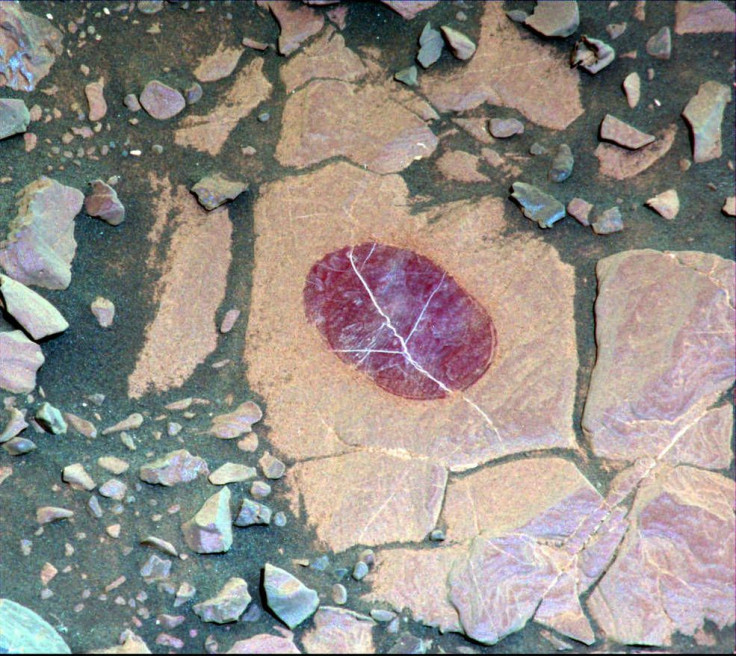NASA's Curiosity Rover's Iron Ore Findings On Mars Show Extensive Water-Rock Interaction

NASA's Curiosity rover boasts of state-of-the-art color discerning capabilities. The rover has been capturing high-resolution images of the surface of Mars since 2012. The various imaging equipment on Mars come with special filters that are helpful for identifying some minerals. Curiosity has now made a map of hematite ore on Mars' surface that points to a higher interaction between water and rock on the planet over time.
NASA’s Curiosity rover is currently climbing a mountainside ridge on Mars. The rover can use the Mast Camera (Mastcam) and Chemistry and Camera equipment (Chemcam) to look at Mars and study it in color. These observations help the team choose areas for the rover to focus on to get richer data.

The Mastcam has two lenses to capture images. There is one telephoto and one wider angle lens. According to a report published by NASA, they have "several science filters that can be changed from one image to the next to assess how brightly a rock reflects light of specific colors. By design, some of the filters are for diagnostic wavelengths that certain minerals absorb, rather than reflect. Hematite, one iron-oxide mineral detectable with Mastcam's science filters, is a mineral of prime interest as the rover examines 'Vera Rubin Ridge,'" which is on lower Mount Sharp.
Earlier spectrometer observations from orbit revealed hematite there which is why the Curiosity was sent there. "Most hematite forms in the presence of water, and the mission focuses on clues about wet environments in Mars' ancient past," said the report. In the early stages of its mission, Curiosity provided evidence for Martian conditions favorable for life. The mission is to figure out the changes that the planet underwent. The rover will study hematite ore, which is very extensively present on the red planets' surface, pointing to a high degree of water-rock interaction during the evolutionary stages of the planet.
"We're in an area where this capability of Curiosity has a chance to shine," said Abigail Fraeman of NASA's Jet Propulsion Laboratory, Pasadena, California, who leads planning for the mission's investigation of Vera Rubin Ridge.
Curiosity's ChemCam studies rocks by shaving off the top layer with a laser to identify chemical elements inside them. It can also do a wide area study of rocks by measuring sunlight reflected by the targets in thousands of wavelengths. Some patterns in this spectral data can identify hematite or other minerals in these rocks.

Hematite has a purplish tint in standard color images from Curiosity due to more reflection of redder and bluer light than of the green wavelengths. The additional color-discerning capabilities of Mastcam and ChemCam show hematite very clearly.
A false-color Sept. 12 panorama photo that combined several Mastcam images taken through three special filters helped provide a map of where hematite could be seen in a region a short distance away. The team had prior knowledge that hematite is found in zones around fractured bedrock.
Curiosity was sent to one of the fracture zones to study the hematite. According to the report, "the investigation with Mastcam, ChemCam and other tools, including a camera and brush on the rover's arm, revealed that hematite is also in bedrock farther from the fractures once an obscuring layer of tan dust is brushed away. The dust doesn't coat the fractured rock as thoroughly."
The findings show that dust and fractures cause the hematite to appear "more patchy than it actually is." If the hematite is widely spread out it pushes back the estimated origin to an earlier period than previously expected. The fluids moved through fractures in the rock much earlier.
"As we approached the ridge and now as we're climbing it, we've been trying to tie what was detected from orbit to what we can learn on the ground," said Curiosity science team member Danika Wellington of Arizona State University, Tempe. "It's still very much a work in progress. The extent to which iron-bearing minerals here are oxidized relates to the history of interactions between water and rock."
"The colors of the rocks on the ridge are more interesting and more variable than what we saw earlier in Curiosity's traverse," science team member Jeffrey Johnson of the Johns Hopkins University Applied Physics Laboratory, said in a news release. "We're using these multi-spectral and hyper-spectral capabilities for examining rocks right in front of the rover and also for reconnaissance -- looking ahead to help with choosing where to drive for closer inspection."
Special camera filters on @MarsCuriosity rover allow it to see Mars' true colors. See what this purplish hue means: https://t.co/7oKYZYy6rQ pic.twitter.com/0a5U9iHDhl
— NASA (@NASA) November 1, 2017
This article has been updated to include more information from NASA on the Mars Curiosity Rover's findings.
© Copyright IBTimes 2024. All rights reserved.





















